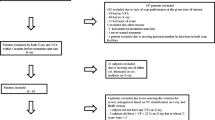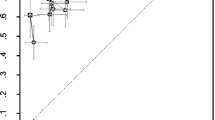Abstract
Introduction
Vertebral fracture is currently underdiagnosed, despite its common severity and its value to predict further osteoporotic fracture. Morphometry using dual X-ray absorptiometry (DXA) [vertebral fracture assessment (VFA)] is a new technique that may facilitate detection of many vertebral fractures, as images are obtained at the same time as bone mineral density (BMD) measurement, and would also allow avoiding spine radiographs.
Methods
We conducted a cross-sectional study to assess the diagnostic value of Instant Vertebral Assessment (IVA), which is a morphometry scan using the Hologic Delphi densitometer, to detect prevalent vertebral fracture in postmenopausal women. Interobserver precision was assessed, then IVA scans were compared with lateral spine radiographs, considered the gold standard, to test diagnostic agreement between the two techniques. Sensitivity, specificity and predictive values were calculated, as well as the likelihood ratio of the positive test, using sensitivity and specificity at each vertebral level.
Results
Among 85 patients of whom 50% had at least one vertebral fracture identified with radiographs, we found that interobserver precision was moderate, with frequent difficulties in discerning upper thoracic vertebrae. On a per-vertebra basis, sensitivity was around 70% from L4 to T11 and lower above T11 whereas specificity was above 90% for all vertebrae, and the negative predictive value remained above 80% from L4 to T7 and decreased above T7. On a per-patient basis, sensitivity was 0.69, specificity 0.74, positive predictive value equalled 0.72 and negative predictive value 0.71. When only grades 2 and 3 fractures were considered, results were comparable, with slightly improved specificity. Then, with the likelihood ratios calculated in our sample, we obtained posttest probabilities using the prevalence of vertebral fracture at lumbar and thoracic levels in a large sample of postmenopausal women with osteopenia and osteoporosis with and without vertebral fracture [baseline data in women of the Multiple Outcomes on Raloxifene Evaluation (MORE) trial]. At levels where fractures were most common, likelihood ratios of the positive test were good or excellent, associated with sizeable posttest probabilities.
Conclusion
IVA allowed diagnosis of vertebral fracture at levels where vertebral fracture were most common, i.e., the lumbar and mid and lower thoracic levels, but its value was weaker at the upper thoracic levels.




Similar content being viewed by others
References
O’Neill TW, Felsenberg D, Varlow J, Cooper C, Kanis JA, Silman AJ (1996) The prevalence of vertebral deformity in european men and women: the European Vertebral Osteoporosis Study. J Bone Miner Res 1:1110–1118
Nevitt MC, Ettinger B, Black DM et al (1998) The association of radiographically detected vertebral fracture with back pain and function: a prospective study. Ann Int Med 15:793–800
Center JR, Nguyen TV, Pocock NA et al (1999) Mortality after all major types of osteoporotic fracture in men and women: an observational study. Lancet 353:878–882
Lindsay R, Silverman SL, Cooper C et al (2001) Risk of new vertebral fracture in the year following a fracture. JAMA 285:320–323
Melton III LJ (1987) Epidemiology of vertebral fractures. In: Christensen C, Johansen JS, Riis B (eds.) Osteoporosis, Copenhagen
Minne HW, Leidig G, Wuster C, Siromachkostov L, Baldauf G, Bickel R, Sauer P, Lojen M, Ziegler R (1988) A newly developed spine deformity index (SDI) to quantitate vertebral crush fractures in patients with osteoporosis. Bone Miner 3:335–349
Eastell R, Cedel SL, Wahner HW, Riggs BL, Melton III LJ (1991) Classification of vertebral fractures. J Bone Miner Res 6:207–215
McCloskey EV, Spector TD, Eyres KS, Fern ED, O’Rourke N, Vasikaran S, Kanis JA (1993) The assessment of vertebral deformity: a method for use in population studies and clinical trials. Osteoporos Int 3:138–147
Meunier PJ, Bressot C, Vignon E, Edouard C, Alexandre C, Courpron P, Laurent J (1978) Radiological and histological evolution of post-menopausal osteoporosis treated with sodium fluoride-vitamin D-calcium. Preliminary results. In: Courvoisier B, Donath A, Baud CA (eds) Fluoride and bone. Hans Huber Publishers, Bern, pp 263–276
Kleerekoper M, Parfitt AM, Ellis BI (1984) Measurement of vertebral fracture rates in osteoporosis. In: Christiansen C, Arnaud CD, Nordin BEC, Parfitt AM, Peck WA, Riggs BL (eds) Copenhagen international symposium on osteoporosis June 3–8, 1984, vol. 1. Department of Clinical Chemistry, Glostrup Hospital, Copenhagen, pp 103–108
Genant HK, Wu CY, van Kuijk C, Nevitt MC (1993) Vertebral fracture assessment using a semiquantitative technique. J Bone Miner Res 8:1137–1148
Gehlbach SH, Bigelow W, Heimisdottir M, May S, Walker M, Kirkwood JR (2000) Reconition of vertebral fracture in a clinical setting. Osteoporos Int 11:577–582
Delmas PD, van de Langerijt L, Watts NB et al (2005) Underdiagnosis of vertebral fractures is a worldwide problem: the IMPACT Study. J Bone Miner Res 20:557–563
Duboeuf F, Bauer DC, Chapurlat RD, Dinten JM, Delmas PD (2005) Assessment of vertebral fracture using densitometric morphometry. A review. J Clin Densitom 8:362–368
Ferrar L, Jiang G, Barrington NA, Eastell R (2000) Identification of vertebral deformities in women: comparison of radiological assessment and quantitative morphometry using morphometric radiography and morphometric x-ray absorptiometry. J Bone Miner Res 15:575–584
Binkley N, Faulkner KG, Kawhara-Baccus, Krueger D, Genant HK, Drezner MK (2002) Use of densitometric lateral assessment to detect prior vertebral compression fracture. J Bone Miner Res 17:S314
Damiano J, Kolta S, Porcher R, Fechtenbaum J, Dougados M, Roux C. Diagnosis of vertebral fracture by instant vertebral assessment. J Bone Miner Res 17:S355
Ferrar L, Jiang G; Eastell R, Peel NFA (2003) Visual evaluation of vertebral fractures in osteoporosis using morphometric X-ray absorptiometry. J Bone Miner Res 18:933–938
Ettinger B, Black DM, Mitlak BH, Knickerbocker RK, Nickelsen T, Genant HK, Christiansen C, Delmas PD, Zanchetta JR, Stakkestad J, Gluer CC, Krueger K, Cohen FJ, Eckert S, Ensrud KE, Avioli LV, Lips P, Cummings SR (1999) Reduction of vertebral fracture risk in postmenopausal women with osteoporosis treated with raloxifene: results from a 3-year randomized clinical trial. Multiple Outcomes of Raloxifene Evaluation (MORE) Investigators. JAMA 282:637–645
Author information
Authors and Affiliations
Corresponding author
Rights and permissions
About this article
Cite this article
Chapurlat, R.D., Duboeuf, F., Marion-Audibert, H.O. et al. Effectiveness of instant vertebral assessment to detect prevalent vertebral fracture. Osteoporos Int 17, 1189–1195 (2006). https://doi.org/10.1007/s00198-006-0121-2
Received:
Accepted:
Published:
Issue Date:
DOI: https://doi.org/10.1007/s00198-006-0121-2




